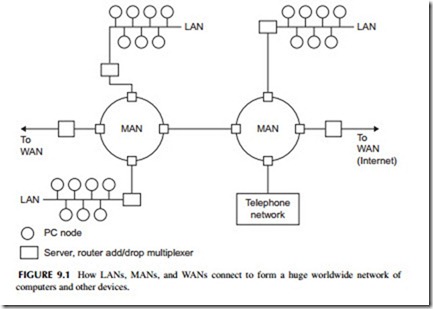TYPES OF NETWORKS
There are lots of different ways to interconnect individual computers or other electronic products. You can do it by electrical cable or fiber optic cable or you can do it in a wireless manner. In any case, each computer or user in the network is called a node. The goal of a network is to connect each node to all other nodes in some way so that they can communicate. Over the years, several different levels of networks have evolved.
Wide Area Networks
A wide area network (WAN) is the largest network of all and we could consider the entire telephone network or the Internet as a large WAN. Sometimes WANs are smaller and may be localized to a country, a state, a city, or other large geographical area. The Internet is certainly a WAN. Most WANs are made up of fiber optic cable so that they can carry lots of data at very high speeds.
Metropolitan Area Networks
A metropolitan area network (MAN) is a network that covers a smaller geo- graphical area such as a city or a large college campus system. Good examples of MANs are the local telephone company and your local cable TV company. MANs are also widely used in large companies and in governments to inter- connect their computers. Most MANs are also implemented with fiber optic cable to maintain speed and data capacity.
Local Area Networks
A local area network (LAN) covers a small group of computers, typically a thousand computers or less. LANs are implemented in companies, small busi- nesses, and even in homes. A LAN may only have a couple of users but could have several hundred, depending on the circumstances. Even two connected PCs at home comprise a LAN. In most cases, LANs are connected externally to a MAN or a WAN for external communications.
Personal Area Networks
Most personal area networks (PANs) are short-range wireless networks. A PAN is formed when two or more computers or cell phones interconnect to one another wirelessly over a short range, typically less than about 30 feet. Most PANs are what we call ad hoc networks that are only set up temporarily for a specific purpose. The Bluetooth headset option on a cell phone is an example of a PAN.
Home Area Networks
A home area network (HAN) is a network inside the home used to provide monitoring and control over energy usage. It connects to the utility’s electric meter and monitors energy usage so the home owner can see what energy is being used and where. It is also used to give the utility a way to control the heating and air conditioning to save energy. The HAN also provides a way to conveniently turn appliances off and on. The HAN may use wireless or com- munications over the AC power line. The HAN is the home portion of the national Smart Grid effort to conserve energy.
Storage Area Networks
A storage area network (SAN), as its name implies, is a network that interconnects large data storage devices to computers and to one another. Large arrays of hard disks are usually set up to store massive amounts of data needed by business, the government, and other organizations. The SAN provides a way to access all this information in a fast and easy way.
Network Relationships
As it turns out, the different types of networks are connected to one another, the result being one massive network. Figure 9.1 is an example. For example, local
LANs are connected to MANs, while the MANs themselves are connected to WANs, and so on. In this figure, the circles represent PCs while the squares rep- resent network connecting points. These include servers, the computers that man- age LANs and MANs; routers, which determine connections in the network; and add/drop multiplexers that put data on the network and take it off. All the inter- connecting links are fiber optic cable except for the copper cable in the LANs. This complex hierarchy essentially lets any computer talk to any other computer under the right conditions. The Internet implements such a hierarchy of networks.
